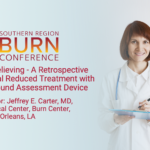Abstract | March 2, 2021
If Seeing Was Believing – A Retrospective Review of Potential Reduced Treatment with a Novel Burn Wound Assessment Device
Learning Objectives
- Participants will be able to recall the average costs per day of inpatient care;
- Participants will be able to recall if more accurate burn wound assessment positively or negatively impacts length of stay;
- Participants will be able to assess if burn wound assessment offers early or later treatment.
Introduction: Burn care (BC) remains a highly specialized and resource intensive specialty with only 2% of hospitals featuring a burn center and less than 1% of graduating general surgery and plastic surgery residents pursing a burn fellowship each year. Access to specialized care is further complicated by burn wound assessment (BWA) which is commonly performed visually without adjunctive devices. To help clinicians make more accurate assessments and potentially reduce delays in transfer or treatment, a new non-invasive imaging device for BWA is being developed using visible and non-visible wavelengths of light with machine learning algorithms. Our goal was to assess the potential reduced treatment delay (RTD) and associated financial savings by implementing such a device using our burn center’s historical data.
Methods: The study was an IRB-approved, retrospective review of admissions from 07/01/2018 through 06/30/2019. Inclusion criteria: thermal, chemical, contact, or electrical mechanism of injury, 15 years of age requiring excision, and length of stay 72 hours. Inclusion data included: presence/absence of concomitant trauma, day of surgery, day of admission, day of electronic order entry for case request, and length of stay per percent total body surface area (LOS%TBSA). RTD was defined starting >48 hours after injury daily until electronic order entry for surgical case request. Reduced costs were calculated per day from prior studies ranging $3,000 to $5,100/day.
Results: A total of 109 patients were included. 29 patients had case requests placed within 48 hours of admission. Of the remaining 80 patients, a potential of 398 days would have been saved had a novel BWA adjunctive imaging devices aided surgeon to requests earlier surgical intervention. Overall savings from reduced length of stay range from $1,194,000 to $2,029,800 dollars.
Conclusions: Our study demonstrates that should a BWA technology with accuracy 48 hours after injury be developed, even burn centers with 24-hour access to operating rooms can reduce treatment delays. The study does not look at additional cost savings offered by reduced emergent transfers or admissions which offer additional intrigue and promise.

